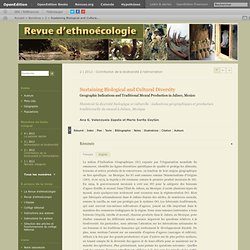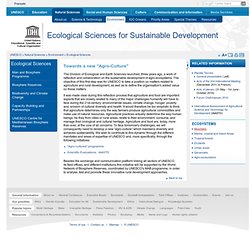

Réseau des grands parcs - Biodiversité urbaine. Montréal, du 21 au 23 mai 2013 Un rendez-vous incontournable !

Tenu les 21, 22 et 23 mai 2013 à Montréal, le Rendez-vous Biodiversité urbaine a fait l’objet d’un compendium, c’est-à-dire une synthèse des approches, pratiques et interrogations échangées sur le thème de la valeur de la biodiversité urbaine lors de l’évènement. Nous vous invitons à en prendre connaissance en le téléchargeant ci-contre, en version française ou anglaise. Cet évènement a été organisé à l’occasion de la rencontre du Comité consultatif des villes du Partenariat mondial sur l'action locale et infranationale pour la biodiversité, en lien avec la Convention sur la diversité biologique des Nations-Unies, dont le Secrétariat est à Montréal. Cette rencontre s’est effectuée dans le cadre des travaux relatifs au Plan d’action sur les gouvernements infranationaux, les villes et autres autorités locales pour la biodiversité et dans le cadre de la Décennie des Nations-Unies pour la biodiversité (2011-2020). Biodiversite culturelle science participative biodiversite domestique michel griffon valorisation de l'heterogeneité.
Sciencie Faculty - University Master in physical Anthropology: Human Evolution and Biodiversity. Master´s Degree in Physical Anthropology: Human Evolution and Biodiversity The human species, “is the highest and most interesting problem for the naturalist "(Letter of Darwin to Wallace, December 22, 1857) “Culture is the ecological niche which man occupies” (Wolpoff, 1971)

Agricultural biodiversity. Unusual strains of maize are collected to increase the crop diversity when selectively breeding domestic corn.

Agricultural biodiversity is a sub-set of general biodiversity. It includes all forms of life directly relevant to agriculture: rare seed varieties and animal breeds (farm biodiversity), but also many other organisms such as soil fauna, weeds, pests, predators, and all of the native plants and animals (wild biodiversity) existing on and flowing through the farm. However, most attention in this field is given to crop varieties and to crop wild relatives. Cultivated varieties can be broadly classified into “modern varieties” and “farmer’s or traditional varieties”. Modern varieties are the outcome of formal breeding and are often characterized as 'high yielding'. Scope[edit] Although the term agricultural biodiversity is relatively new - it has come into wide use in recent years as evidenced by bibliographic references - the concept itself is quite old. Human dependency[edit] Cultural Biodiversity.
Biodiversity & Cultural Diversity. Diversity: Cultural and biological. Early human populations utilized a wide range of biological resources in a tremendous diversity of environments.

As a result, they possessed high levels of cultural diversity dependent on and supportive of high levels of biological diversity. This pattern changed drastically with technological innovations enabling certain human groups to break down territorial barriers and to usurp resources of other groups. The dominant groups have gone on to exhaust a whole range of resources, depleting both biological and cultural diversity. Traditions of resource conservation can, however, re-emerge when the dominant cultures spread over the entire area and the innovations diffuse to other human groups.
This could change once again as genetically engineered organisms become an economically viable proposition with the accruing advantages concentrated in the hands of a few human groups: a further drastic reduction in biological and cultural diversity may ensue. Sustaining Biological and Cultural Diversity. 1In the last decade, researchers have addressed issues regarding the biological conservation of agaves and the use of traditional knowledge in relation to mezcal production (Valenzuela-Zapata and Nabhan 2004).

The Agave genus is well represented in Mexico, numbering 150 species of a total of 200 species (García-Mendoza 2002). About 20% of the species (42) are used to produce mezcal in 26 different states throughout the republic (Colunga et al. 2007). The name “mezcal” encompasses a broad category of distilled agave drinks. Additionally (and confusingly), “mezcal” is the name of a specific distilled agave drink that is protected by Denomination of Origin (DO) legislation and is also a term that Mexicans colloquially use to refer to agave. Agro-culture. The Division of Ecological and Earth Sciences launched, three years ago, a work of reflection and collaboration on the sustainable development of agro-ecosystems.

The objective of this first step was for UNESCO to take a position on matters related to agriculture and rural development, as well as to define the organisation's added value on these matters. It was made clear during this reflection process that agriculture and food are important aspects that are closely related to many of the major challenges humanity will have to face during the 21st century: environmental issues; climate change; hunger; poverty; and, erosion of cultural diversity and health.
It would therefore be too simplistic to think that agriculture determines only the way farmers produce agricultural commodities and make use of natural resources. Unesdoc.unesco.org/images/0013/001322/132262e.pdf. A recipe linking nature and people. These simple representations, or the so called conceptual framework, provide a shared language and a common set of relationships and definitions.

This week these experts presented their views to more than 100 governments gathered in Bonn for the First Session of the IPBES Plenary, the highest governing body of the Platform. Local and Indigenous Knowledge. As the world changes increasingly rapidly, 'Local Knowledge, Global Goals' explores the ways that indigenous and local knowledge systems contribute to understanding, mitigating and adapting to climate change, environmental degradation and biodiversity loss.

The 'Local Knowledge, Global Goals' poster series and publication introduce important concepts and emerging issues relating to indigenous and local knowledge systems and their interactions with science and policy. Each poster presents a key concept or issue, and supplements it with case studies from around the world. The publication expands on the case studies, giving added detail and context. Together or separately, they are a resource that can be used by teachers, researchers or policy-makers wanting to explore or discuss concepts and best practice relating to indigenous and local knowledge systems in present day contexts. View the publication here. The Intersections of Biological Diversity and Cultural Diversity: Towards Integration Pretty J, Adams B, Berkes F, de Athayde S, Dudley N, Hunn E, Maffi L, Milton K, Rapport D, Robbins P, Sterling E, Stolton S, Tsing A, Vintinnerk E, Pilgrim S - Conservat.
There is an emerging recognition that the diversity of life comprises both biological and cultural diversity. In the past, however, it has been common to make divisions between nature and culture, arising partly out of a desire to control nature. The range of interconnections between biological and cultural diversity are reflected in the growing variety of environmental sub-disciplines that have emerged. Biological Diversity and Cultural Diversity: From Race to Radical Bioculturalism. Journal of Cultural Heritage Management and Sustainable Development. Joe Henrich. Culture Cognition and Coevolution Lab. My primary research interests focus broadly upon how ecological variables influence cross-cultural differences and social behaviour.

Disease, for example, has ubiquitously posed a threat to humans throughout their history. It's therefore worth considering the implications that ecological variables such as disease might have for social behaviour, and for the evolution of cultural systems as well. Centre for the Coevolution of Biology and Culture.